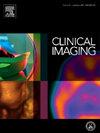Lateral-arm approach decreases clip migration in stereotactic breast biopsies
IF 1.8
4区 医学
Q3 RADIOLOGY, NUCLEAR MEDICINE & MEDICAL IMAGING
引用次数: 0
Abstract
Aim
Stereotactic-guided vacuum-assisted biopsy (STVAB) is the standard of care to biopsy mammographically detected breast lesions without a sonographic correlate. It can be performed using the conventional (CBA) or lateral-arm biopsy approach (LABA). Tissue marker (clip) placement is routinely done post-biopsy. Clip migration is frequently encountered in STVAB and can result in higher rates of positive margins and re-excision in subsequent surgery. We sought to compare clip migration rates between CBA and LABA.
Materials and methods
We performed a retrospective review of 347 cases performed at an Asian institution from 2021 to 2024, on predominantly dense breasts. We compared clip migration rates between CBA and LABA. Other factors that were known to contribute to clip migration were also studied, including breast density and hematoma size. Statistical analysis was done using Fisher's exact test, Mann–Whitney U test and linear regression models.
Results
A total of 347 biopsies were performed. CBA was performed for 297 (85.6 %) patients and LABA was performed for 50 (14.4 %). LABA was found to significantly reduce clip migration rates compared to CBA (4 % versus 25.9 %, p < 0.001). Breast density (p = 0.55) andhematoma size (p = 0.662) were not found to significantly affect clip migration rates.
Conclusion
We recommend utilizing LABA over CBA whenever technically possible if we wish to minimize clip migration.
侧臂入路在立体定向乳房活检中减少夹片迁移
目的立体定向引导真空辅助活检(STVAB)是乳房x光检查发现的乳腺病变的标准护理,没有超声相关。它可以使用常规(CBA)或侧臂活检方法(LABA)进行。组织标记(夹子)的放置在活检后常规进行。在STVAB中经常遇到夹子移动,并且在随后的手术中可能导致较高的阳性边缘和再切除率。我们试图比较CBA和LABA之间的夹子迁移率。材料和方法我们对2021年至2024年在亚洲一家机构进行的347例病例进行了回顾性分析,主要是致密性乳房。我们比较了CBA和LABA之间的clip迁移率。研究人员还研究了其他已知的导致夹子迁移的因素,包括乳腺密度和血肿大小。统计分析采用Fisher精确检验、Mann-Whitney U检验和线性回归模型。结果共行活检347例。297例(85.6% %)患者行CBA, 50例(14.4% %)患者行LABA。与CBA相比,LABA显著降低了夹子迁移率(4 %对25.9 %,p <; 0.001)。乳腺密度(p = 0.55)和血肿大小(p = 0.662)对夹子迁移率无显著影响。结论:我们建议在技术允许的情况下使用LABA而不是CBA,如果我们希望减少夹子的移动。
本文章由计算机程序翻译,如有差异,请以英文原文为准。
求助全文
约1分钟内获得全文
求助全文
来源期刊

Clinical Imaging
医学-核医学
CiteScore
4.60
自引率
0.00%
发文量
265
审稿时长
35 days
期刊介绍:
The mission of Clinical Imaging is to publish, in a timely manner, the very best radiology research from the United States and around the world with special attention to the impact of medical imaging on patient care. The journal''s publications cover all imaging modalities, radiology issues related to patients, policy and practice improvements, and clinically-oriented imaging physics and informatics. The journal is a valuable resource for practicing radiologists, radiologists-in-training and other clinicians with an interest in imaging. Papers are carefully peer-reviewed and selected by our experienced subject editors who are leading experts spanning the range of imaging sub-specialties, which include:
-Body Imaging-
Breast Imaging-
Cardiothoracic Imaging-
Imaging Physics and Informatics-
Molecular Imaging and Nuclear Medicine-
Musculoskeletal and Emergency Imaging-
Neuroradiology-
Practice, Policy & Education-
Pediatric Imaging-
Vascular and Interventional Radiology
 求助内容:
求助内容: 应助结果提醒方式:
应助结果提醒方式:


